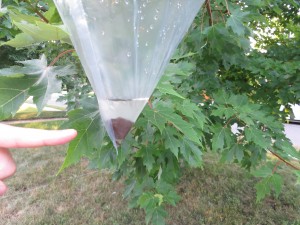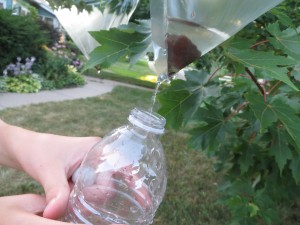Tag: survival’
Survival Science: Shelter
- by KitchenPantryScientist
Katniss Everdeen had a sleeping bag to keep her warm at night in “The Hunger Games,” but what if you found yourself in the wilderness without a sleeping bag, or even a tent?
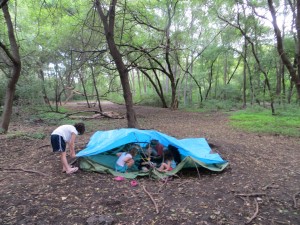
The healthy human body maintains a constant temperature between 97.7 and 99.5 degrees Fahrenheit through a process called thermoregulation. To do this, our bodies constantly produce heat and then give it off. Heat can be lost through the processes of conduction (losing heat by contact with another object, like the cold ground,) convection (losing heat to air or water moving across your skin,) radiation (loss of heat through infrared rays), and evaporation (heat loss as water turns to gas, like when sweat evaporates.)
If your body temperature gets too low, you can suffer from a potentially deadly condition called hypothermia. (Hypo=under, thermia=heat) Or, if you get too hot, you can suffer from Hyperthermia, which can lead to heat stroke. (Hyper=over, thermia=heat)
A shelter can protect you from the sun, storms and the elements and help you keep your body temperature steady as you wait for help to arrive, and one of the best items to include in your survival kit is a black plastic “contractor” bag. These large bags can be used as rain gear to keep you dry (cut a hole in the top for your head) or to protect you from wet ground below in your shelter. You can even fill one with leaves to use as a makeshift blanket. A nylon cord, or rope should also be included in a survival kit and can be used for a number of things including building shelters.
 There are lots of ways to build shelters, but grab an old tarp or some big plastic bags, some rope and head to a park, woods or a local nature center to build a shelter. You’ll learn a few things and it’s tons of fun!
There are lots of ways to build shelters, but grab an old tarp or some big plastic bags, some rope and head to a park, woods or a local nature center to build a shelter. You’ll learn a few things and it’s tons of fun!
You can make a “bent sapling shelter” by bending a small tree down and tying it to the base of a nearby tree. Then put your tarp or bag over the sapling. You could also tie your rope between two trees and hang the tarp over that.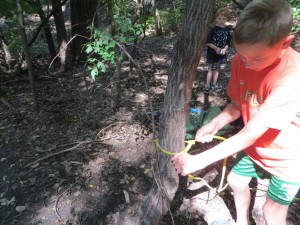
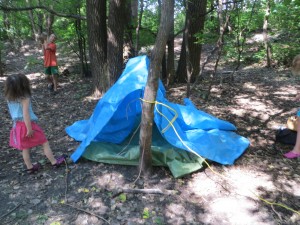
Make an A-frame shelter by lashing two branches together and leaning a long branch between them. 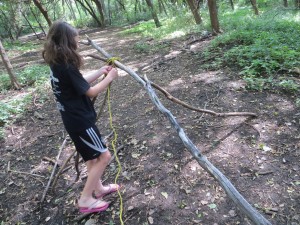
Then, cover it with your plastic bag or tarp.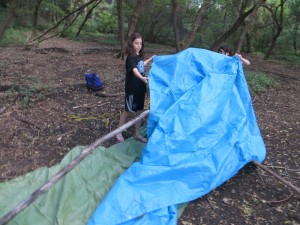
You can use small sticks as stakes! 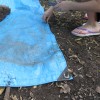
What if you don’t have a tarp? Try building a shelter from branches you find and weaving tree branches or birch bark through the sticks.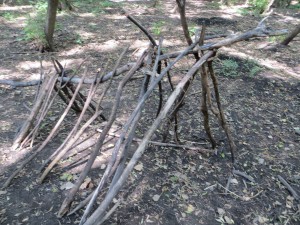
Imagine that there’s a thunderstorm coming from the Northwest and build your shelter with that in mind. Look up! Are there dead branches or rocks that could fall on you? Use existing trees, downed branches and rocks to build your shelter. Can you anchor it with rocks, sticks and your rope? Remember, you want it large enough to lie down in, but small enough to conserve heat.
Make teams and have a contest to see who can build the best shelter!
Katniss would be proud!
Survival Science: Water Filters
- by KitchenPantryScientist
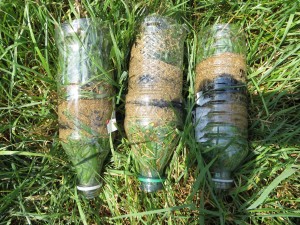 I demonstrated this experiment on Kare11. Click here to watch the clip.
I demonstrated this experiment on Kare11. Click here to watch the clip.
Don’t drink the water you purify when you do this experiment at home, since it may still contain harmful microbes!!! You can use homemade Petri dishes to see how clean you got your water though, by swabbing the unfiltered water on one dish and the water you purified on another to see what grows!
If you’re desperate for water, and you don’t have a plastic bag, or it’s too cloudy or cool to get water from tree respiration, you can always look for a pond or stream as a water source. Unfortunately, pond and stream water is often teeming with life, and some of the bacteria, viruses, parasites, protozoa and fungi in the water can make you sick. Boiling water purifies it, but what if you can’t make a fire? Katniss had Iodine in her backpack, which is another great way to kill microorganisms and purify water, but what if you don’t have iodine or a water filter?
If you’re in a survival situation, it’s important to do everything you can to make sure the water is safe, before you drink it! The first thing you have to do is make the water you find clear enough to read a paper through (get out the gunk, in other words.) Then, you have to put it in the sun for six hours so ultraviolet rays will kill anything living in the water. Digging a hole next to a pond and collecting the water that seeps in will pre-filter the water for you!
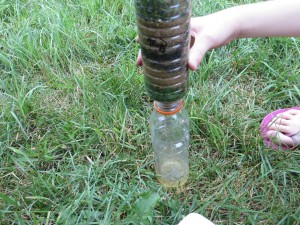
Using grass, charcoal, sandy soil, you can make a water filter. A plastic water bottle with the bottom cut off works best as a filter-holder, but you can use a cone made of birch bark if you don’t have a bottle!
We cut the bottoms off of some water bottles, pounded up some charcoal (you could use campfire coals for the charcoal layer!), pulled some grass and found some sand (don’t use sand from a sandbox, which may contain cat feces.)
Next, we layered grass, charcoal and sand in our bottles, packing each layer down as much as possible. I tried grass, charcoal, sand, charcoal and more grass, but the girls made more layers than I did. We wrote down what we did to see who got the cleanest water!
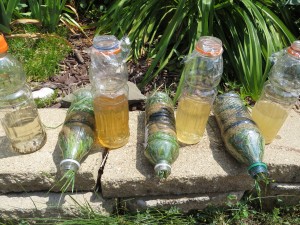
Then, we poured stream water through our filters and collected what flowed through in empty sports drink bottles. We covered the bottles and left them in the sun for at least six hours. Last night, we stuck cotton swabs in each water sample and swabbed homemade petri dishes to test the water for fungi and bacterial growth. (You can’t see viruses, but the sun will often kill them efficiently.) Our controls were stream water that was unfiltered and keep out of the sun and stream water that was unfiltered, but put in the sun with the other samples. Note: If you want to make petri dishes to test your water, use agar instead of gelatin to make the plates! Some bacteria are good at breaking down gelatin, turning it into a liquid, and this happened to a few of our samples (including the unfiltered water.)
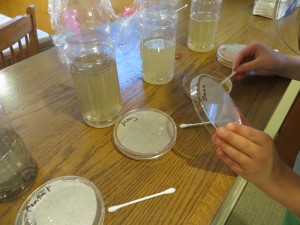
We observed that putting the water through our filters made it yellow and one sample was a little cloudy, so it will be interesting to see how it compares to the stream water we didn’t filter or put in the sun. It would be fun to test the filter ingredients to see what made it yellow.
Survival Science: Water Collection
- by KitchenPantryScientist
At the beginning of “The Hunger Games,” by Suzanne Collins, the heroine Katniss risks her life to retrieve an orange backpack and a sheet of plastic. In the backpack, she finds a black sleeping bag, a pack of crackers, a pair of dried beef strips, a bottle of iodine, a box of wooden matches, a small coil of wire, a pair of night glasses, a bottle of iodine and a half-gallon plastic bottle for carrying water. According to the book “Stay Alive,” by John D. McCann, she’s off to a pretty good start in terms of basic survival. He says that the following components should be included in any survival kit: fire and light, signalling, water and food collection, knives and tools, shelter and protection, navigation, and medical. I demonstrated how to do this experiment on Kare11. Click here to watch the clip.
The survival “Rule of Three” says that you can go 3 minutes without air, 3 hours without shelter (from heat or cold), 3 days without water and 3 weeks without food. That means that water is one of the first things you have to think about in a survival situation. Your body is about 75% water.
If it’s hot outside, you can easily collect water from non-poisonous leafy trees using a plastic bag. Clear works best, like a large oven bag. (Ours was for turkeys!)
Yesterday, we took 2 bags outside and put them over tree branches, enclosing as many maple leaves as we could and putting a small rock in the corner of each bag to weight them. Finally, we tied them around each branch securely with a twisty-tie. What else could you use if you didn’t have a tie? A shoelace? After 24 hours, we collected our water by cutting the corner of the bag and collecting it in a clear bottle.
Katniss had iodine to purify her water, but if you don’t have a water filter or iodine tablets to kill harmful bacteria, viruses and parasites, you could filter the clear water from plant transpiration through cloth, like a tee shirt or bandana, and leave it in a clear bottle in the sun for 6-10 hours to kill most pathogens. Don’t try drinking the water you get from this experiment, as it may not be safe!
Why to trees produce water? All plants carry water from their roots to small pores called stromata on the underside of their leaves. These pores release water into the air in a process called transpiration. Transpiration helps cool plants, but is also involved in moving nutrients from root to leaf. Plants transpire the most on hot, dry days and trees that have gotten plenty of water give off the most water. According to the U.S. Geological Survey, a large Oak tree can transpire 40,000 gallons of water a year! Our area is very dry at the moment. We probably could have collected more water from our tree following some rain!
So, as of today, our survival kit will include a pocket knife, a clear plastic oven bag, and a bandana. What should we add next?
Katniss Camp: Survival Science
- by KitchenPantryScientist
This week, the kids and I are embarking on a survival science camp. We won’t face starvation or dehydration, but we’ll learn some wilderness survival skills and the scientific concepts behind them. You could put some of these ideas together and take a group of kids to a local park or nature center for a fun, educational field trip or birthday party!
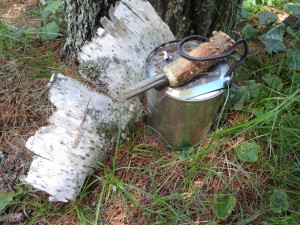
We’re planning to learn about the best way to collect and purify water, how to figure out which way is North, how to build a shelter and stay warm, the art of making a whistle from an acorn and what really works for building a fire (with adult supervision, of course.) Along the way, we can talk about practical things- like what to do if you get lost.
We visited our library and checked out “STAY ALIVE- Survival Skills You Need” by John D. McCann for inspiration and information.
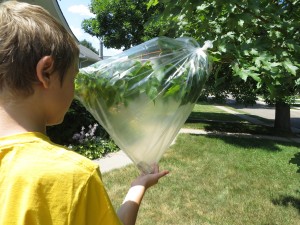
Today, we kicked things off by making a TRANSPIRATION bag, which is a solar still assembled using a clear oven bag, a twisty-tie, and a non-poisonous tree (like a maple.) I’ll write more about transpiration tomorrow, when we measure how much water we’ve collected! We read that in a sunny spot, you can collect between 1 and 2 cups a day.
